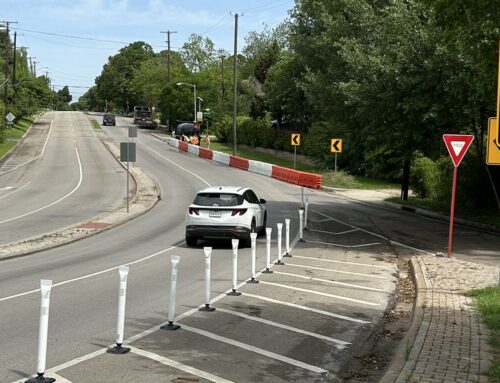A common hesitancy in welcoming new development to an established neighborhood is how the future might clash with history.
For months a committee of neighborhood residents and property owners have been studying land uses along Bishop and Davis, which are lined with historical buildings that developed around the old streetcar lines. The committee’s proposed changes along these streets would allow for taller buildings with residential units stacked on top of retail shops, restaurants or office buildings. But the committee also wants to encourage any landowners or potential developers to reuse the historical buildings already in place.
To this end, they came up with the concept of “contributing structures”, a term planners use to describe buildings that date back to a neighborhood’s original architecture.
“These buildings are really assets to the neighborhood because of their scale and character,” explains architect Larry Good of Good, Fulton & Farrell, the consultant hired to facilitate the study.
The committee decided that the biggest enemy of these historical buildings is the city’s parking requirements, which were created post-World War II but are being applied to structures built before cars were common.
One example of this is the old theater building on the southeast corner of Clinton and Davis, says Paul Maute, a Winnetka Heights resident and the committee’s vice-chairman.
“It’s not been used as a theater forever,” Maute says. “There are a couple of parking spots on the street right out in front of it, but that’s it. For somebody to go in there now, the parking would be looked at in accordance with the new zoning requirements, and they’re stuck.”
By and large, Dallas retail stores are required to provide five parking spaces per 1,000 square feet, and office spaces are required to have three per 1,000 square feet, Maute says. For restaurants, since roughly half of their square footage is kitchen and storage space, the formula requires a certain amount of parking per square footage of service space, which amounts to more than would be required for a retail or office building.
When developers build new structures, they can design a site to meet these requirements. But in the case of existing buildings — like the stretch of vintage retail across from Winnetka Heights that “people feel an affinity for because of its age and character,” Maute says — the space is much harder to occupy because “it’s a classic case of zoning requirements coming in after something was built,” he says. “Retailers really have to struggle to make it work.”
The committee has pinpointed more than 100 historical structures along Bishop, Davis and other nearby streets, and wants to ease up on parking requirements for these buildings, plus make Tax Increment Financing (TIF) funds available for reimbursement of certain renovation costs.
At a recent neighborhood meeting where the latest version of the Bishop/Davis land use study was presented, Good suggested reducing the parking requirements to zero for any of these buildings reused as retail or office space. This would be a “clear incentive” for someone to go in and use a space that currently is not leasable, Maute says.
Of course, this begs the question of where people would actually park, since “space is at a premium and parking is such an emotional issue,” Maute says. “The grand idea is you’ll be able to account for that parking space some other way.”
One option might be parking lots in strategic places along Bishop and Davis. The study’s supporters, however, are hailing it as a plan that would encourage more walking and cycling, and possibly an eventual streetcar line, so that people won’t have to use their cars and parking wouldn’t be an issue.
The specifics, both for the incentives and how they would logistically work, aren’t yet nailed down.
Doing all of this wouldn’t necessarily prevent a developer from coming in and tearing down a historical building; that would take legal restrictions, and the committee believes owners of contributing structures would fight new rules that take away their property rights. Instead, the committee “recommends the carrot over the stick” with concessions that will make preservation more financially feasible.
Visit advocatemag.com and click on “blog” to find a list of the contributing structures identified by the committee, and on “multi- media” to view a slideshow of some of these historical buildings.





